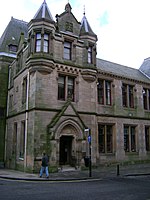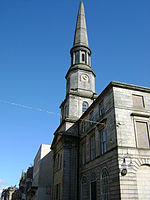Dunfermline City Chambers
1879 establishments in ScotlandBuildings and structures in DunfermlineCategory A listed buildings in FifeCity chambers and town halls in ScotlandClock towers in the United Kingdom ... and 5 more
Gothic Revival architecture in ScotlandGovernment buildings completed in 1879Listed government buildings in ScotlandPolitics of DunfermlineUse British English from April 2022

Dunfermline City Chambers is a municipal facility at the corner of Bridge Street and Kirkgate in Dunfermline, Fife. The building, which serves as home to the local area committee of Fife Council, is a Category A listed building.
Excerpt from the Wikipedia article Dunfermline City Chambers (License: CC BY-SA 3.0, Authors, Images).Dunfermline City Chambers
Kirkgate, Dunfermline Central Dunfermline
Geographical coordinates (GPS) Address External links Nearby Places Show on map
Geographical coordinates (GPS)
| Latitude | Longitude |
|---|---|
| N 56.0708 ° | E -3.464 ° |
Address
Dunfermline City Chambers
Kirkgate
KY12 7NA Dunfermline, Central Dunfermline
Scotland, United Kingdom
Open on Google Maps










